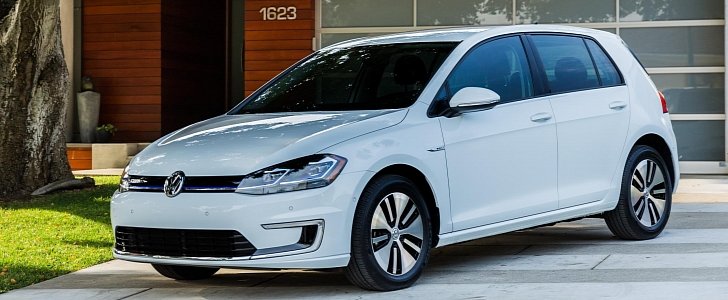The e-Golf is the first Golf facelift model to be presented in the United States, and that has to do with where production takes place. Just a day after the Germans got theirs, Californians with a green conscience have the first details about the US-spec version.
Arriving this spring as a 2017 model year, the updated e-Golf promises an EPA-estimated 125 miles of range, 50% more than the outgoing car. This has everything to do with a new lithium-ion battery with an increased energy capacity of 35.8 kWh from 24.2 kWh. But that's still almost half the range of the Chevy Bolt, which is 238 miles.
Improved battery chemistry has also made the 2017 e-Golf more efficient. For city driving, the EPA estimated fuel economy is 126 MPGe; highway driving is rated at 111 MPGe, and combined city/ highway at 119 MPGe, improved over the 2016 EPA estimates of 126, 105 and 116, respectively.
This is one of those rare occasions when a car offers more of everything, and we believe it. There's even a new motor with extra power, as the e-Golf has gone from 115 horsepower to 134 horsepower in one model year. At the same time, the maximum torque has been boosted from 199 pound-feet to 214 lb-ft. The 2017 e-Golf is said to run from zero to 60 mph faster than its predecessor, taking 9.6 seconds and reaching a top speed of 93 mph.
We don't have any photos of the interior, so the digital dashboard might or might not be available. But the photos confirm full-LED headlights and revised taillights, but not the same ones they have in Europe.
The 7.2 kW onboard charger is now standard on both SE, and SEL Premium trims, letting you reach full capacity in six hours on a 240V charging station. When equipped with DC Fast Charging (optional on SE, standard on SEL Premium), the battery can be charged to 80 percent within an hour. Volkswagen estimates that using 13 cents per kilowatt-hour, you can expect annual fuel costs to go down by $550.
Improved battery chemistry has also made the 2017 e-Golf more efficient. For city driving, the EPA estimated fuel economy is 126 MPGe; highway driving is rated at 111 MPGe, and combined city/ highway at 119 MPGe, improved over the 2016 EPA estimates of 126, 105 and 116, respectively.
This is one of those rare occasions when a car offers more of everything, and we believe it. There's even a new motor with extra power, as the e-Golf has gone from 115 horsepower to 134 horsepower in one model year. At the same time, the maximum torque has been boosted from 199 pound-feet to 214 lb-ft. The 2017 e-Golf is said to run from zero to 60 mph faster than its predecessor, taking 9.6 seconds and reaching a top speed of 93 mph.
We don't have any photos of the interior, so the digital dashboard might or might not be available. But the photos confirm full-LED headlights and revised taillights, but not the same ones they have in Europe.
The 7.2 kW onboard charger is now standard on both SE, and SEL Premium trims, letting you reach full capacity in six hours on a 240V charging station. When equipped with DC Fast Charging (optional on SE, standard on SEL Premium), the battery can be charged to 80 percent within an hour. Volkswagen estimates that using 13 cents per kilowatt-hour, you can expect annual fuel costs to go down by $550.





